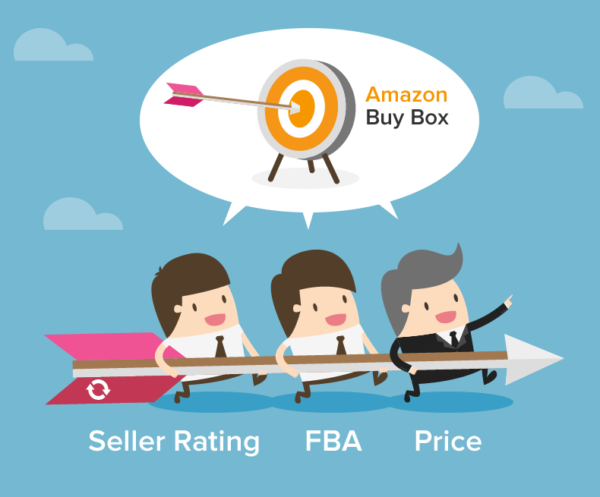— February 9, 2018
Once you’ve found the perfect product to sell on Amazon, you need a solid pricing strategy and if you have enough products, a repricing tool to keep your prices competitive and ensure you make a profit. There are many factors to consider when setting your price including how much you paid for the item, how your competition is priced and your current sales rank.
In this post, we’ll be looking at Amazon pricing strategies (which can be applied manually or automatically) to help you maximize your sales and profits.
Pricing Too High or Pricing Too Low
If you price too high — you’ll be left with stock that sits around collecting dust — but price too low and things will be flying off your shelves at the expense of your profits. The key is finding the “sweet spot” — where you can profit nicely and still entice buyers.
If you’re a seller on Amazon and want to achieve your Buy Box dreams — then check out this compilation of our favorite pricing strategies. Someone once said, “money can buy everything except time”, but with a repricing solution, that is exactly what you’re buying.
1. Don’t Be the Cheapest Seller
It’s a common assumption to make: price your inventory at the lowest level, and people will flock to your page?
Well, yes, they will — but not for the right reasons. If you do it often enough, buyers may perceive your products as poor quality instead of competitively affordable and it’ll quickly become a race to the bottom (which you want to avoid).
What we suggest you do instead is to price your products 1.5% above the lowest seller. This way, you don’t get caught up in a race to the bottom, but you’re still competitively priced.
FBA seller Ryan Grant uses this as his default strategy across 75% on his inventory, allowing him to win a share of the Buy Box and maximize the value he receives for each sale. An alternative strategy used by FBA seller, Kev Blackburn, is to always set your min (floor) selling price at 30% above your cost price plus fees.
Kev takes a long-term approach to pricing and only adjusts his prices after three months.

2. Do as Others Do
If you don’t want to follow the above pricing strategies, here’s one that’s closely related but works differently. Instead of nearly price-matching the cheapest sellers, turn to your FBA competitors and see what prices they’re using.
Matching the lowest FBA competition will result in an increase in sales but reduce your profit margin.
This more aggressive pricing strategy may be useful to help make a quick sale to increase product reviews, or shift some stock which has been hanging around for a while in Amazon’s warehouses and has long-term storage fees due soon. Learn how to avoid Amazon’s long-term storage fees.
With a repricing solution, you easily set a min (floor) price for your items which you will never go below. You can also exclude sellers with poor Amazon seller metrics or a history of undercutting, and avoid getting involved in a price war that hurts your profits.

3. Work Your Intelligence and Experience
Don’t forget to use your intelligence and experience to best implement your pricing strategies: This includes doing things like:
- Anticipating competitors’ trends.
- Using past information to make future decisions.
- Realising the difference between an item that’s a lost cause (and in need of a quick sale) and one that just needs a little boost.
- Deciding when to use repricing and when to bundle, upsell or do something else to move an item.
Long-term success on Amazon needs data at its foundation.

4. Identify What Needs to be Repriced First
Before you rush out to stick a virtual “for sale” sticker on your entire inventory, take a step back and evaluate what order you should be repricing things in.
For example, your ‘sitters’ (those pesky products that seem to love the FBA warehouse more than being in a buyer’s hands) should probably get looked at first, so you don’t get stuck with outdated stock.
Another strategy is to start at the top in terms of what costs the most in your inventory, and then knock a few dollars off it. Shoppers who’ve had their eye on a high-priced item will get excited as the item becomes more affordable.
5. Use Software to Apply the Principles of Supply and Demand
Repricing is relatively easy when it comes to supply and demand. If there are more items than buyers, then the shoppers can be picky about prices and hold out until the price lowers. Conversely, if they can’t resist the hottest toy and are in fierce competition with each other, then you can increase the price and enjoy a little more profit!
Amazon repricing software, such as RepricerExpress , essentially allows Amazon sellers to automatically compare their product prices to those of competitors’ and adjust them accordingly (within the min and max prices you set).
Sellers’ prices are so closely linked to their sales performance and product visibility on Amazon that they need to continually ensure their products are priced competitively. Doing this manually if you have hundreds or thousands of products simply isn’t viable. With an increasing number of sellers using repricing software, it is becoming an essential part of your eCommerce business, not just a nice tool to have.
In terms of repricing strategy, remember that repricing software is still only a tool and you’ll get the best results from it if you set it up to suit your overall business goals, and identify who you do and don’t want to compete with.
Although there are many sellers on Amazon selling the same products, they are all different businesses, with different circumstances, goals and inventory lists. A modern repricing solution gives you the ability to set your repricing rules to sell your stock in the way you need to, at the price you’re prepared to sell at.
Final Thoughts
There isn’t a single pricing strategy that’s going to work for every seller in every situation. It’s up to each individual to devise a pricing strategy that supports their goals and is in line with their brand values.
Some strategies will succeed right away, while with others, you’ll have to do a bit more experimenting. You need to balance the act of putting the customer first whilst still making a profit. If you’ve got a lot of items in your inventory, it’s time-consuming to manually reprice every single one of your listings, so it makes sense to use a repricing solution.
Digital & Social Articles on Business 2 Community
(81)







